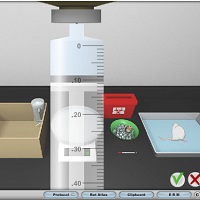Virtual Neuroscience Lab #2: Parkinson's Study
IMPORTANT NOTICE
The Parkinson's Virtual Lab is an interactive science lab created in Flash. As of January 1st, 2021 Flash was retired and is no longer supported by Internet browsers. The lab is still available in a modified "video" version (an .mp4 file). In this version you watch a person going through the entire lab, click-by-click. If you pay careful attention to everything that happens -- pausing the video to read all the text, examine all images, and note every significant step in the process -- you will have a very similar experience to doing the lab yourself and you will learn all the same things. Detailed instructions follow below.
|
CONTRIBUTORS:
Paul Garris: Project Leader, Author, Storyboards Kevin Stewart: Animations, Artwork, Programming, Audio/Video Engineering, Design David Leech Anderson: Author, Storyboards Robert Stufflebeam: Artwork, Author, Design |
Darci J. Harland: Storyboards Elisa L. Palmer: Author, Storyboards Andrew Kenning: Author, Storyboards Ji Zheng: Animations, Artwork |
 |
MODULE DESCRIPTION: Parkinson's Disease damages the brain's ability to perform normal motor functions. Scientists have discovered that these motor deficits occur because of the loss of dopamine neurons, What remains surprising, though, is the fact that a patient can lose 80% of the dopamine neurons before any symptoms are evident. But how is that possible? How does the body compensate for this loss and continue to function normally with only 20% of the original dopamine neurons. This is a virtual lab where the student become a neurobiologist using state-of-the-art techniques to implant electrodes into the brain of a (virtual) rat and to take readings of dopamine levels to test two competing theories that seek to explain how the body "compensates" for the loss of neurons. |
MODULE COMPONENTS
VIDEO INTRODUCTION (For Teachers Only)
A brief video introduction to The Mind Project's Virtual Neuroscience Lab #2: Parkinson's Study. This video was created to familiarize teachers with the experience a student will have of the lab. We recommend that students do not see this preview because it has spoilers that will reduce the fun of discovery and it will reveal aspects of the lab that students should have to deduce themselves.
Introduction to Virtual Parkinson's Lab (6 Minute Video)
A 6 minute video giving a brief introduction to instructors about the main goal of this virtual science lab. Not recommended for students (too many spoilers).
Student Resources
These are handouts for students to use while they are doing the virtual lab.
Teacher Resources
Professional Development Guide for Teachers (34 pages)
This is an extensive professional development manual to provide teachers with everything they need to successfully implement this lab in the classroom.
Parkinson's Lab Summary Report
This is an extensive professional development manual to provide teachers with everything they need to successfully implement this lab in the classroom.
THE VIRTUAL PARKINSON'S LAB
This lab was originally created in Flash and was a fully-interactive lab that functioned like a video game. Flash is no longer supported by browsers so this lab was converted to video. In the video version you watch a person going through the entire lab, click-by-click. The video offers little time for you to read the on-screen text or study the images. This is by design; it gives you more control. Pause the video each time a new screen appears. Read the text, and pay careful attention to all activities. If you do all of that, you will have a very similar experience to doing the original version of the lab and, most importantly, you will learn all the same things. In addition to the video, there are supporting materials that will aid you as you work through the lab. These include The Electronic Medical Record (ERM) - available in both .pdf and video versions - and a final summary page.
PART ONE: THE VIDEO
Open this video in a browser. Pay careful attention to everything that happens on the screen and PAUSE THE VIDEO to read all of the text. The video purposely gives little time for reading text so each person can pause the video for as long as is needed. The text gives instructions for things you must do as well as information you must record and analyze. Some of the text exists on separate webpages that are easier to read (see Part Two below).
VIRTUAL PARKINSON'S LAB: Video Version PART TWO: SUPPORTING MATERIALS
While doing the video lab, you will view the ERM (Electronic Medical Record), a medical reference with important information crucial to completing the required tasks. The pages of the ERM are visible in the video but you may find it more convenient to read the sections of text in the provided .pdf file and to access the video version of the ERM in a separate video window.
Electronic Medical Record (ERM)
ERM - Electronic Medical Record - PDF Version (Text & Images only; Video content below)
RELATED MODULE
Parkinson's Disease: A Debate about its Nature & Cause
OVERVIEW OF "Virtual Neuroscience Lab #2: Parkinson's Study"Our immersive Virtual Parkinson's Lab takes several hours of focused engagement to complete. In contrast, this is a single webpage with a dozen of the most important embedded Flash animations together with text that explains much of the scientific content that students will learn from doing the lab. Some teachers will choose to have their students carefully read this page and engage the animations, rather than completing the entire virtual lab. And for those who have completed the lab, this is a convenient summary of much of the key content.
Parkinson's Disease: A Debate about its Nature & Cause This is a resource that will offer a convenient and powerful review of much of the main content of the full virtual Parkinson's lab: Virtual Neuroscience Lab #2: Parkinson's Study.
CREDITS:
Funding: This module was funded by a Science Education Partnership Award (SEPA) #R25RR020425, supported by the National Center for Research Resources (NCRR), which is part of the National Institutes of Health (NIH).


